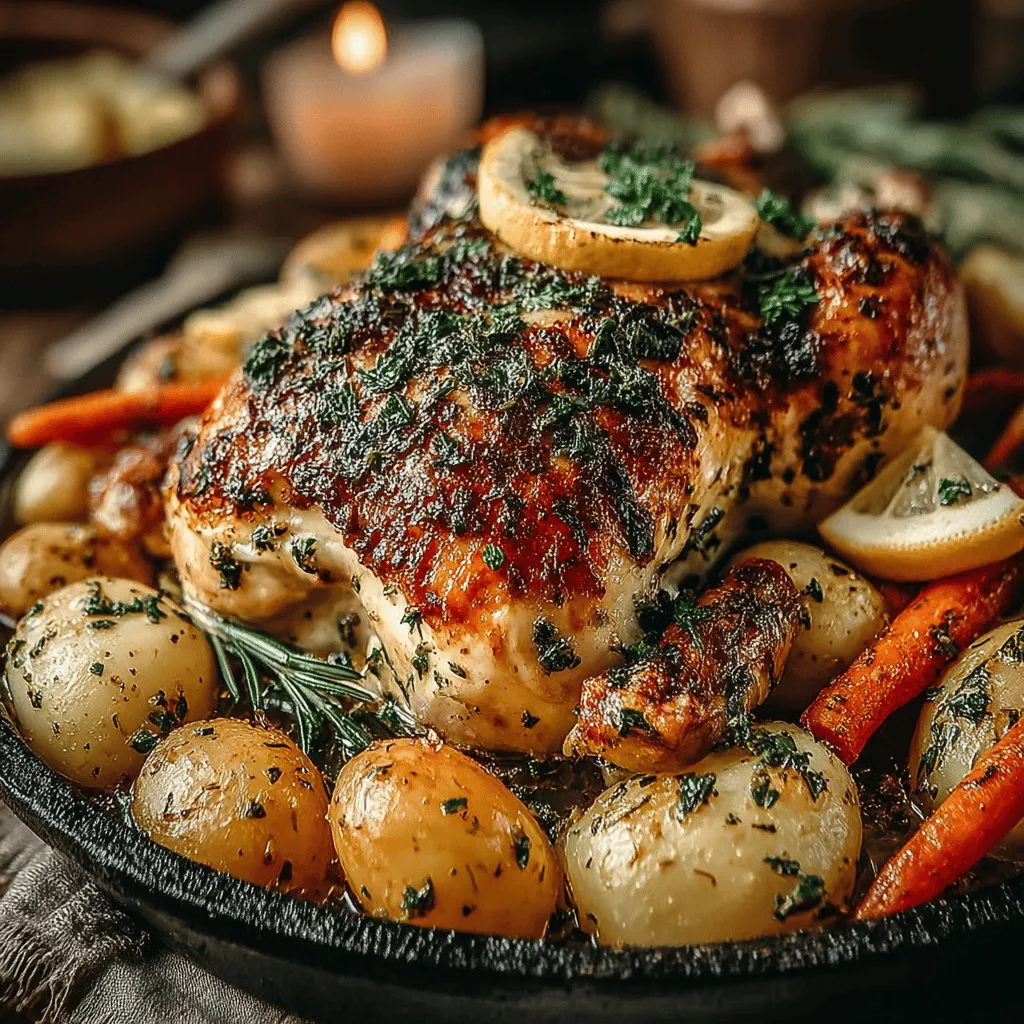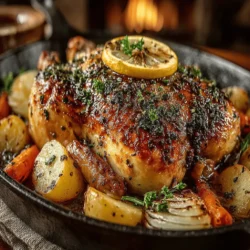Herb-Roasted Whole Chicken: A Flavorful Family Feast
Introduction
In the world of home cooking, few dishes are as comforting and satisfying as a perfectly herb-roasted whole chicken. This classic recipe is not just a meal; it’s an experience that transforms any ordinary dinner into a celebration. The sight of a golden-brown chicken, with its crispy skin glistening from the oven, evokes a sense of warmth and nostalgia. When seasoned with a harmonious blend of fresh herbs, zesty lemon, and accompanied by seasonal vegetables, this herb-roasted chicken becomes a culinary delight that fills the kitchen with enticing aromas and brings families together around the dining table.
The origins of roasting chicken can be traced back to ancient times when cooking meat over an open flame was a common method. As culinary techniques evolved, roasting became a favored technique, allowing the flavors of the meat and herbs to meld beautifully. Today, the herb-roasted whole chicken is a staple in many households, beloved for its simplicity and the delicious comfort it provides. Whether you are preparing a Sunday dinner, hosting a holiday gathering, or simply treating yourself to a hearty meal, this dish stands out as a timeless favorite.
In this article, we will explore the step-by-step process of preparing this exquisite dish, diving into the nutritional benefits and historical backgrounds of each ingredient. We’ll also share invaluable tips to ensure your herb-roasted chicken turns out perfectly every time.
Understanding the Ingredients
Delving into the components of the herb-roasted whole chicken reveals the thoughtfulness behind each selection. Understanding these ingredients not only enhances the flavor but also contributes to a more nutritious meal.
The Whole Chicken: Selecting the Right Bird
Choosing the right chicken is crucial for achieving the best flavor and texture. Opting for organic and free-range chickens is recommended, as they are raised in healthier conditions and often have a richer taste compared to conventional chickens. Organic chickens are typically fed a natural diet free from antibiotics and hormones, which can impact the quality of the meat.
When selecting a chicken, consider its size and weight. A bird weighing between 3.5 to 5 pounds is ideal for roasting, as it will cook evenly and provide enough meat for several servings. Additionally, a smaller chicken tends to be more tender and flavorful, making it a preferred choice for roasting.
Herbs and Seasoning: Nature’s Flavor Enhancers
The key to an unforgettable herb-roasted chicken lies in the herbs and seasonings used. Fresh rosemary, thyme, and sage each bring their unique flavor profiles to the dish. Rosemary has a robust, pine-like flavor that pairs beautifully with poultry, while thyme adds a subtle earthiness. Sage, with its slightly peppery taste, rounds out the flavor profile, creating a well-balanced seasoning mix.
Incorporating sea salt and freshly cracked black pepper is essential for enhancing the natural flavors of the chicken. Sea salt not only assists in drawing out moisture, helping to achieve that coveted crispy skin, but it also elevates the overall taste. Garlic is another crucial ingredient, known for its ability to enhance flavor profiles and add depth to the dish. Whether used whole, minced, or roasted, garlic infuses the chicken with a delightful aroma and savory taste.
Citrus Twist: The Power of Lemons
Lemons play a pivotal role in this recipe, contributing both moisture and flavor. Their acidity helps to tenderize the meat, ensuring a juicy chicken that is bursting with flavor. The science behind using citrus in roasting lies in its ability to break down proteins, resulting in a more tender and flavorful dish. Additionally, the zesty aroma of lemon fills the kitchen, creating an inviting atmosphere.
When preparing the chicken, consider using both the juice and the zest of the lemon. The zest adds a vibrant citrus flavor, while the juice infuses moisture. Placing lemon halves inside the cavity of the chicken during roasting enhances the overall flavor and aroma, creating a dish that is not only visually appealing but also irresistibly fragrant.
Vegetable Medley: A Colorful Accompaniment
Accompanying the herb-roasted chicken is a medley of seasonal vegetables that not only complements the dish but also provides nutritional benefits. Carrots and potatoes are classic choices, offering natural sweetness and hearty textures. Carrots are a great source of beta-carotene, fiber, and antioxidants, while potatoes provide essential vitamins and minerals.
Onions, too, play a significant role in enhancing the flavor depth of the dish. As they roast alongside the chicken, they caramelize, releasing their natural sugars and adding a layer of sweetness that balances the savory elements of the meal. Together, this colorful vegetable medley elevates the dining experience and ensures a nourishing meal.
Preparation Steps for the Perfect Roast
A well-prepared chicken ensures a delightful meal. To achieve culinary perfection, it’s essential to follow a few key preparation steps that will set the foundation for your herb-roasted whole chicken.
Essential Tools and Equipment
Before diving into the preparation, gather the necessary tools and equipment. A sturdy roasting pan is vital, as it not only holds the chicken but also collects the flavorful drippings for gravy or sauce. A meat thermometer is essential for monitoring the internal temperature, ensuring the chicken is cooked to perfection without being overdone.
Other useful kitchen utensils include basting brushes for applying marinades or juices during roasting and sharp carving knives for serving. Having these tools on hand will streamline the cooking process and enhance your overall experience.
Preparing the Chicken: From Drying to Seasoning
One of the keys to achieving crispy skin is drying the chicken thoroughly before seasoning. Pat the chicken dry with paper towels, ensuring that moisture is minimized. This step is crucial, as excess moisture can lead to steaming rather than roasting, resulting in a less desirable texture.
Next, create the herb mixture by combining finely chopped fresh herbs, minced garlic, sea salt, and black pepper in a small bowl. This aromatic blend will be rubbed all over the chicken, including under the skin, allowing the flavors to penetrate the meat. The process of seasoning under the skin is essential, as it ensures that every bite is infused with herbaceous goodness.
As you prepare the chicken, take a moment to appreciate the importance of each ingredient. The combination of fresh herbs, zesty lemon, and quality chicken creates a symphony of flavors that will leave your family and friends asking for seconds.
Stuffing and Arranging: Building Flavor Layers
To maximize flavor infusion, consider stuffing the chicken with lemon halves and a few sprigs of herbs before roasting. This not only enhances the taste but also contributes to the aromatic experience as the chicken cooks. Properly stuffing the chicken helps to keep it moist and flavorful throughout the roasting process.
When it comes to arranging the vegetables for roasting, place them in a single layer around the chicken in the roasting pan. This allows for even cooking and flavor distribution, ensuring that the vegetables absorb the delicious drippings from the chicken as they roast. The combination of roasted chicken and caramelized vegetables creates a delightful harmony of flavors that is both satisfying and nourishing.
In the next section, we will delve into the roasting process itself, where the magic truly happens. From preheating the oven to achieving that perfect golden-brown finish, every step is crucial for delivering a meal that will be remembered long after the last bite.

Understanding How Temperature Affects Cooking Time
When it comes to roasting a whole chicken, understanding the relationship between temperature and cooking time is crucial for achieving the best results. Roasting at the correct temperature not only ensures the chicken cooks evenly but also helps to develop a golden, crispy skin while keeping the meat juicy and tender.
Monitoring Cooking Time and Temperature
Ideal Roasting Time Based on Chicken Weight
The general rule of thumb for roasting a whole chicken is to allow approximately 20 minutes per pound at a temperature of 375°F (190°C). This means that:
– A 3-pound chicken will take about 60 minutes.
– A 4-pound chicken will take about 80 minutes.
– A 5-pound chicken will take about 100 minutes.
However, these times can vary based on your specific oven and the chicken’s initial temperature. Always check for doneness rather than relying solely on timing.
Using a Meat Thermometer for Perfect Doneness
The most reliable way to ensure your chicken is perfectly cooked is by using a meat thermometer. Insert the thermometer into the thickest part of the thigh, avoiding the bone. The internal temperature should reach 165°F (75°C) for safe consumption. If you prefer a more tender chicken, you might aim for an internal temperature of 175°F (80°C) for even more moist meat.
Recognizing Visual Cues of a Well-Roasted Chicken
In addition to using a meat thermometer, there are visual cues that indicate your chicken is done. Look for the following signs:
– The juices should run clear when the chicken is pierced at the thigh, indicating that it is fully cooked.
– The skin should be a deep golden-brown color, indicating a well-roasted exterior.
– The legs should move freely in their sockets, which is a sign that the meat is tender.
Resting: The Key to Juiciness
After removing the chicken from the oven, it’s essential to let it rest before carving. This step is often overlooked but is crucial for retaining moisture.
Why Resting is Crucial for Moisture Retention
Resting allows the juices within the chicken to redistribute throughout the meat. If you carve the chicken immediately, the juices will spill out onto the cutting board, leading to drier meat. A resting period of 15 to 20 minutes will ensure that each slice is juicy and flavorful.
Tips for Ensuring the Chicken Stays Warm During Resting
To keep your chicken warm during the resting period, loosely tent it with aluminum foil. This will trap heat without steaming the skin, which can make it lose its crispiness. If you anticipate a longer wait, you can place the chicken in a warm oven (around 200°F or 93°C) while it rests.
Serving Suggestions: Elevating Your Meal
Once your herb-roasted chicken is perfectly cooked and rested, it’s time to serve it. Presentation plays a significant role in enhancing the dining experience.
Carving the Chicken: Techniques for Presentation
Carving a whole chicken can seem daunting, but with the right technique, you can achieve a beautiful presentation.
Step-by-Step Carving Instructions for a Beautiful Presentation
1. Prepare Your Tools: Use a sharp carving knife and a sturdy cutting board.
2. Remove the Legs: Start by pulling the leg away from the body. Cut through the joint that connects the leg to the body. Repeat with the other leg.
3. Separate the Thigh and Drumstick: Find the joint between the thigh and drumstick and cut through it to separate the two pieces.
4. Remove the Breasts: Make a long cut along the breastbone, then slice downwards to remove the breast meat in a single piece. Repeat on the other side.
5. Serve: Arrange the leg quarters and breast slices on a platter, ensuring the presentation is appealing.
How to Plate the Chicken and Vegetables Attractively
Enhance your presentation by surrounding the chicken with roasted vegetables. Arrange colorful vegetables, such as carrots, potatoes, and Brussels sprouts, around the chicken on the serving platter. This not only adds visual appeal but also provides a delicious side that complements the chicken.
Garnishing: Adding the Final Touch
A simple garnish can elevate your dish significantly.
The Role of Fresh Parsley in Enhancing Visual Appeal
Chop fresh parsley and sprinkle it over the chicken and vegetables for a pop of color. This not only enhances the visual appeal but adds a fresh flavor that complements the herbs used in the chicken.
Suggestions for Complementary Side Dishes to Serve Alongside
To create a complete meal, consider serving your herb-roasted chicken with a variety of side dishes. Here are some suggestions:
– Garlic Mashed Potatoes: Creamy potatoes that provide a comforting flavor.
– Roasted Seasonal Vegetables: Bright vegetables bring color and nutrients to the plate.
– Simple Green Salad: A light salad with a vinaigrette dressing can balance the richness of the chicken.
– Wild Rice or Quinoa: These grains add texture and are a healthy addition to your meal.
Nutritional Benefits of Herb-Roasted Chicken
Understanding the nutritional aspects of your meal can create a more fulfilling dining experience. Herb-roasted whole chicken is not only flavorful but also packed with nutrients.
Protein Power: The Benefits of Chicken
Overview of Lean Protein and Its Importance in a Balanced Diet
Chicken is an excellent source of lean protein, which is essential for muscle growth and repair. A 3.5-ounce (100-gram) serving of cooked chicken breast contains about 31 grams of protein, making it a perfect choice for those looking to maintain or build muscle mass. Additionally, lean proteins are lower in saturated fats compared to red meats, contributing to heart health.
Nutritional Comparison of Roasted Chicken Versus Fried Options
When comparing roasted chicken to fried chicken, the nutritional benefits become even more apparent. Roasted chicken retains its natural juices without the added calories and unhealthy fats from frying. While fried chicken can significantly increase calorie intake and unhealthy fat consumption, herb-roasted chicken remains a healthy option that can easily fit into a balanced diet.
Herbs and Vegetables: A Nutritional Boost
Benefits of Fresh Herbs in Combating Inflammation
The fresh herbs used in this recipe, such as rosemary, thyme, and parsley, are not just for flavor; they also offer various health benefits. Many herbs have anti-inflammatory and antioxidant properties, which can help reduce the risk of chronic diseases. Incorporating these herbs into your meals can enhance both the taste and health benefits of your dishes.
Nutritional Profiles of the Accompanying Vegetables
The vegetables that accompany herb-roasted chicken provide additional nutrients. For example:
– Carrots: High in beta-carotene, which is essential for eye health.
– Brussels Sprouts: Rich in vitamins C and K, and a great source of fiber.
– Potatoes: Provide potassium and vitamin C, ensuring your meal is both nutritious and satisfying.
Cultural Significance of Roasting Chicken
Roasting chicken is a cherished tradition in many cultures around the world, and understanding its historical context can deepen your appreciation for this beloved dish.
Historical Context: Roasting Chicken Through the Ages
The practice of roasting poultry dates back thousands of years. Ancient civilizations, such as the Egyptians and Romans, used various cooking methods to prepare chickens, often using herbs and spices to enhance flavor. Roasting became a popular technique in the Middle Ages, where it was common for large gatherings and feasts, symbolizing abundance and hospitality.
Modern Variations: Global Influences on Roasted Chicken
Today, many cultures have put their unique spin on roasted chicken, incorporating local herbs and spices to create distinct flavors. For example:
– French Coq au Vin: A classic dish where chicken is braised in red wine with mushrooms and lardons.
– Peruvian Pollo a la Brasa: Marinated chicken roasted over charcoal, known for its crispy skin and flavorful meat.
– Indian Tandoori Chicken: Chicken marinated in yogurt and spices, then cooked in a tandoor oven for a smoky flavor.
These global variations highlight the versatility of chicken and how it can be adapted to different culinary traditions, enriching the dining experience.
Conclusion
Herb-roasted whole chicken is more than just a meal; it’s a celebration of flavors, traditions, and family gatherings. With its enticing aroma and tender meat infused with fresh herbs and lemon, this dish is sure to impress. By understanding the ingredients, preparation techniques, and serving suggestions, you can elevate your culinary skills and create a memorable dining experience. Whether it’s a Sunday dinner or a special occasion, this recipe promises to be a favorite that brings loved ones together around the table. Embrace this timeless dish and make it a part of your culinary repertoire, celebrating the joy of cooking and sharing good food with those you love.


